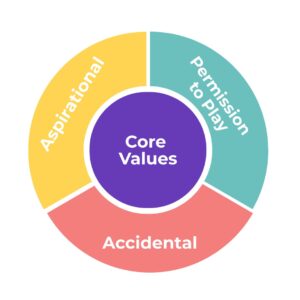Do your core values turn up on the wall?
Do the values you have really resonate within your organisation? Do you have values that are wholeheartedly embraced within your organisation? Right now, can you recite your organisational values, do you know what they are and why they are important? If you answer no to any of these questions, then your organisational values don’t have an impact and in all likelihood are merely a marketing strategy.
A key challenge is determining what those values are
Organisations who have values truly internalised will have higher levels of productivity, employee engagement and almost certainly a positive impact through every aspect of the business. A key challenge is determining what those values are. To be more specific what your ‘Core Values’ are. What’s often very interesting is various values exist in the organisation and they turn up every day in the behaviours we see. The challenge may be that they aren’t the values we’d expect to see.
A natural place to start is to determine what the core values are
Mining for values is a great way to get started in establishing what values are going to serve the organisation well. Mining for core values means you have to start, literally, digging around to unearth what is important to the team, what they can relate to and believe in. A natural place to start is to determine what the core values are. Those values which are truly internalised by everyone. They enrol and inspire the team; everyone understands what they are and how they turn up every day. They form the bedrock of the team’s behaviours.
Now this doesn’t need to be an exhaustive list seeking to cover every angle of human interaction and behaviour, far from it. You need 3 – 5 core values that form the core of the organisation. They are differentiators, they have impact and meaning within the organisation’s context. Whilst it may be expressed through standard terminology the internal comprehension has greater depth with those it is shared with.
You have to go beyond a list of core values…
Having established the core values it is vital that these are communicated throughout the organisation, observed in the daily behaviours and rituals. There needs to be openness to challenge when they are not present regardless of who and celebrated and recognised for there positive impact. They must be measured in their application, appraised against individuals and introduced with pride when inducting new team members or speaking to customers, prospects and visitors.
Once the core values have been established, embedded and understood you will then naturally start to look towards the next 3 layers of values, the permission to play values, our aspirational values and articulate what we identify as our accidental values. With an internalised set of core values, you’ll naturally start to see these other values turn up.
Permission to play values
These are required to ‘get the job done’. The standards we seek to set within the organisation. What are the core values we need to encourage the team to higher levels of productivity which support our core values? During my military service, our core values were clearly internalised by all and our permission to play values were utter professionalism at all times, appropriateness and lawful.
Aspirational Values
These are focused on the characteristics that the organisation wishes it already had and believes it must truly develop. These are focused on the aspirational qualities the organisation seeks to embrace. They are adopted intentionally and agreed that the organisation will do its best to adopt them. The likelihood is these core values will not turn up naturally or inherently and must therefore be purposefully pursued.
Accidental Values
We can see evidence within the organisation although they have appeared unintentionally. As the core values really start to take hold, or more precisely as the team truly internalise the core values there is a ‘like attracts like’. Almost by accident, we start to see values that we want to fully adopt. It’s also worth noting that aspirational values can sometimes go unnoticed. As a result of the core value impact and attracting like-minded people to the organisation new values can appear and just be adopted. So it’s always good to remain tuned into the internalisation of the values and impact over time.

Establishing the core values within an organisation will impact significantly on its very existence. It will dramatically impact organisational health. The challenge for many organisations is they never truly establish and internalise the core values. They see the values as marketing collateral, that look good on the website or framed on the wall. If you require additional support with identifying or creating the core values in your organisation, this resource may be useful.
Interestingly establishing the core values can be uncovered in 3 steps.
- Take a look around the organisation and identify those employees who already epitomise all that is good about the organisation. Then ask yourself (and the leadership team) what it is about them you admire and why their behaviours epitomise the organisation.
- Then take a look at those employees who despite their talents and technical ability would not be missed in the organisation. What is it about those that make them a distraction to others and lower value in contribution?
- Finally, where do the leaders fit in terms of their behaviours? Holding the mirror up to take a long look at yourself and what you’ve discovered observing the first 2 steps will potentially offer some harsh realities.
From here there is no escaping what you can determine as the first steps to establishing the core values. Be mindful that this is the first step and from here it will take time to distil and refine the core values, it will challenge the leadership team to hold the mirror up for themselves and maybe face some harsh truths. Nonetheless from here, you will determine what your core values are and start down the road of internalisation.
Here you can see how our ‘Core Values’ impact our organisation.





